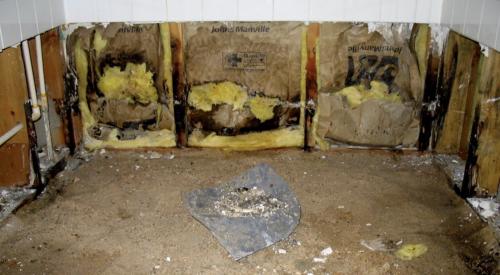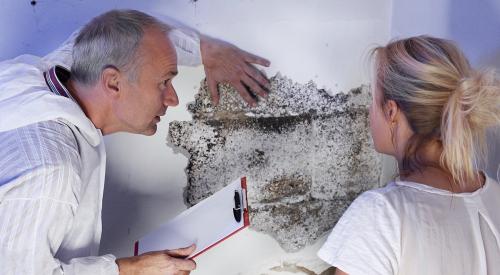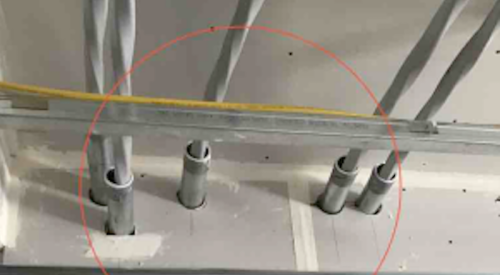A year ago, the hysteria surrounding several high-profile court judgments had many lawyers chortling that mold in homes soon would turn into the mother lode of construction defect litigation—the new asbestos. It hasn't happened, for a number of reasons.
How Mold Problems Are Not Like Asbestos Issues
1. Mold is a different level of hazard
Mold is nowhere near the health hazard of asbestos. While prolonged exposure to interior mold might aggravate allergies and asthma in some people, no life-threatening illness is directly associated with mold.
"In spite of the three-ring circus treatment it gets in the media, mold is just mold," Dave Golden, director of commercial lines for the National Association of Independent Insurers, told a recent meeting of the American Society of Heating, Refrigerating and Air-Conditioning Engineers. "It's been around forever, it's easily remediated, and its health threat has been greatly exaggerated and virtually unproven by scientific fact."
Golden cited a recent study by the American College of Occupational and Environmental Medicine, saying, "Current scientific evidence does not support the proposition that human health has been adversely affected by inhaled mycotoxins (mold) in home, school or office environments."
RELATED
- Mold Remediation: Telling Fact From Fiction
- 5 Steps to Proper Mold Removal
- Is There Mold in New Construction Homes?
2. Health risks from mold are not the same
While the health risks associated with mold remain open to debate, it's clear that it takes exposure to a lot of mold over a substantial period to have any adverse impact. And smart builders are seizing that time to protect themselves.
The large, deep-pocketed public builders were immediately targeted by plaintiffs' attorneys for mold lawsuits. They are the leaders in developing strategies and operational methods to reduce exposure to claims.
"We have published our mold protocol and offered it to anyone who wants it," says Tom Brick, who directs quality initiatives for Lennar Corp. "If any builder has a high-profile mold case, it hurts all of us. We need to stop these problems across the industry. We've probably sent our protocol to 50 builders."
Responding quickly to mold problems, a plumbing leak or water intrusion into the home is a common component of all the Giant builders' mold strategies.
"Most mold comes from plumbing leaks," D.R. Horton president Don Tomnitz says, "so we make certain that any time we have a leak, we get out there to fix it."
Jack Herbstreit, vice president of construction for The Drees Co., formed mold response teams in each region where the firm builds. "Our in-house people are allowed to clean up 30 square feet of mold," he says. "Above that, we go to a professional mitigation company."
Building science consultant Joe Lstiburek, Ph.D., works with builders all over North America to improve construction techniques and reduce mold problems. While the science is complex and solutions vary from region to region, he also sees speedy response to problems as the critical step to staying out of court.
"Builders should just take a Valium and relax," Lstiburek says. "Mold is a water problem. Find the source of the water, fix it and clean up the damage. If you make a good-faith effort on all of that, you won't face punitive damages. The attorneys are not interested in you unless you stonewall it and maintain there is no problem. Fix it, tell the truth and get on with your life."
3. Builders are taking steps to mitigate mold
While speedy resolution of mold problems is critical to staying out of court, many builders are going to extreme measures to keep their houses free of mold, both during construction and after occupancy. For instance, many are trying to eliminate mildew on framing lumber.
"In Albuquerque [N.M.], we have an inspector going through our houses at framing stage to make sure there's no mold on the lumber before it’s covered up with drywall," Tomnitz says. "If he finds any, the lumber supplier has to either remove the moldy pieces or scrape it and treat it."
Herbstreit requires delivery of panels and trusses closer to Drees' installation. "We don't want them on site for more than a week," he says, "and we cover them up to keep them out of the weather. We also require the manufacturer to cover them at the plant before they’re shipped to us."
Perhaps the best news for builders is that consumer media are beginning to run stories that defuse the mold hysteria. "A year ago, there were a lot of scare stories in the local papers," says Kevin Egan, chief operations officer for Dallas-based Darling Homes. "More recently, we see the papers running stories in the other direction "that mold is not that dangerous as a health issue."












